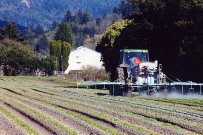Siskiyou Land Conservancy owns 80 acres of rare plant habitat on the North Fork Smith River, in Del Norte County. Botanists, including U.S. Fish and Wildlife Service scientist Dave Imper (quoted below), contend that this Stony Creek property ranks among the top 10 most biologically important private parcels in the north state, owing to its unique and pristine plant communities.
Following is an article that ran in the current (October 2009) issue of Econews, the newsletter of the Northcoast Environmental Center.
By Greg King
A group of unusual and rare plants in the North Fork Smith River area is threatened by fast-growing shrubs that formerly were held in check by fire.
Most travelers on U.S. Highway 199, between Crescent City and Oregon, unwittingly speed past this international botanical treasure. Yet just a half mile north of the Gasquet store is a trail that enters another world: The North Fork Smith River Botanical Area.

Looking down the North Fork Smith River to Siskiyou Land Conservancy's Stony Creek parcel. Photo by Greg King.
For decades hikers, rafters and plant enthusiasts have explored this rocky, almost eerie wonderland of weird soils and crazy flora.
The trail enters the Stony Creek watershed, where botanists have discovered not one or two, but three carnivorous plants living side by side. (See: “Carnivorous Plants of the Smith River Region,” ECONEWS, June 2009.) Also found at Stony Creek are the western bog violet and a dozen other rare plants including the lovely McDonald’s rockcress, which is federally listed as an endangered species. Stony Creek, it turns out, is a gateway to one of the world’s most unique botanical communities.

Stony Creek is alive with Darlingtonia, one of three carnivorous plants in the watershed. Photo by Greg King.
I discovered the Stony Creek Watershed ten years ago while identifying “inholdings” (private parcels surrounded by public lands) for Siskiyou Land Conservancy. I was looking for parcels in the Smith River National Recreation Area that might be in need of conservation protection. Since it turned out that Stony Creek is the North Fork’s only roadless tributary, this was an important inholding.
“The Smith River’s north fork is a country of sparse vegetation, serpentine barrens, and extensive soggy fens,” writes John Sawyer, professor emeritus at HSU, in his seminal 2006 book, Northwest California: A Natural History. “This is the land of the Josephine ophiolite, which boasts the highest number of endemic vascular plants (70) of any outcrop of serpentine substrates on the continent.”
While the professor has retired from teaching, he has not retreated from his passion for plants. His enthusiasm for the unusual soils and resulting flora of the North Fork Smith River remains unabated.
“The fens of this area are famous for the insectivorous California pitcher plant (Darlingtonia californica),” writes Sawyer. “Growing with this remarkable plant is a diverse set of wet-adapted species, many associated with bog and fen conditions in Canada, including the insectivorous butterwort and sundew. … The botanically famous Stoney Creek Trail is an excellent introduction to the serpentine plants of the Josephine ophiolite.” (The creek name is alternately spelled with and without the “e,”depending on document.)
But Sawyer, who has been studying Stony Creek for the past four decades, is concerned. While the parcel remains untouched by road or machinery, to say it’s “pristine” is to ignore the important missing element: fire.
Prior to white settlement, fire in the region of the North Fork-Middle Fork Smith River was a regular occurrence. Lightening fires often spread through the area, and Tolowa Indians burned to maintain dominance of acorn-bearing oak trees. Now, after a century without fire, said Sawyer, the North Fork’s rare plant communities are threatened by a “densification” of shrub species.

Western azalea overlooking the North Fork Smith River, on the 80-acre parcel owned by Siskiyou Land Conservancy. Photo by Greg King.
“Just leaving it alone is mismanagement,” he said. Because the areas containing rare plants are relatively small, Sawyer recommends “reducing the number of trees and cutting the shrubs back” by hand in these regions, rather than using fire, which is less predictable.
After my first visit to the Stony Creek watershed in 2000, I contacted Nan Croley, who owned the 80-acre parcel containing the rare plant communities that botanists have been visiting for nearly 100 years. After four years of negotiating and fund raising, Siskiyou Land Conservancy purchased the parcel as an ecological preserve.
Croley, who has since died, had previously declined to sell the land to Six Rivers National Forest due to concerns that the government would allow logging of the pristine hillside forest on the parcel’s south side.
Siskiyou Land Conservancy is now developing a long-term management plan to restore and protect the rare plant habitat on this parcel, as well as on surrounding federal lands and an adjacent 120 acres owned by the California Department of Fish and Game.
Dave Imper, a botanist with the U.S. Fish and Wildlife Service, agrees that a plan for managing and restoring the North Fork’s rare plant habitat is important.
“It [the Stony Creek parcel] is the best jewel around. … It would be nice to get it mapped and figure out where exactly the rare plants are,” said Imper. Once the inventory is complete, he continued, a restoration program should move forward. If a such a program is not put in place soon encroaching shrub species could suck up the seeping surface water that many of the rare plants require for survival.
“As these [rare plant habitats] close up they dry up,” said Imper, “and there go the carnivores.”

